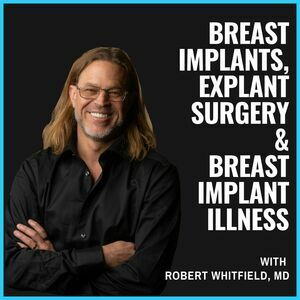Episode 57
ENCORE: How You Can Prevent Breast Implant Illness
March 14th, 2024
7 mins 19 secs
Your Hosts
Tags
About this Episode
How can you prevent breast implant illness?
We’ve already defined what breast implant illness is in the previous podcast episode. It’s a broad term but to put it simply, it is a component of the overall inflammation in your system.
There’s also a need to look at the other components that contribute to your overall inflammation in order to prevent breast implant illness or at least prevent it from worsening. That’s why we have to identify food sensitivities as well. We have to look at how your body absorbs the food you consume.
An analysis of your stool sample’s DNA may be conducted to identify what stimulates you to become inflamed from your diet. However, it remains to be a tough challenge understanding and diagnosing how much inflammation someone has.
Consequently, it’s difficult to understand and diagnose breast implant illness because of that. With my experience of doing thousands of explants, I already know my way through this.
One of the potential ways to reduce your risk of developing inflammation that contributes to breast implant illness is identifying your surgeon for the best possible operative procedure whether it’s for reconstructive or cosmetic surgery. It greatly helps to have a great and trusted surgeon to discuss your condition with.
Choosing the right implant for your patient.
It’s important to carefully choose the right implant for your patient. The size of the implant must fit the frame of the patient while still giving an aesthetic outcome.
Make sure to monitor the status of your patient and her implant throughout the patient’s healing journey not just during the first year but also for the subsequent years to ensure that there are no issues. In my clinic, we have been using a high definition ultrasound for monitoring.
If there’s a change in implants, check with your provider to see if there is a change.
For those who noticed any changes in your implants, make sure to check with your provider to confirm if there’s any noticeable change or trauma. After that consultation, make sure to follow up just to make sure.
There are alternative therapies for those who are not comfortable with the risks associated with breast implants. We perform fat transfer for patients seeking natural breast augmentation. It accentuates the natural breasts’ form and unlike in an implant, it’s between the skin and fatty layer and above the breast tissue.
It’s difficult to change more than a cup size with a fat transfer so if you’re the patient, clearly set out your expectations with regard to what you’re seeking to change visually.
It’s important to make sure that the patients understand all the risks and benefits of the procedures. For fat transfer, factors such as the skin stretch, overall breast size, pregnancies and other history of the patient who wants to get a cup size change are taken into consideration.
As for breast implants, the patients are informed about the risks of breast implant associated cancers and other risks associated with the development of breast implants. That’s why having a qualified professional surgeon who is knowledgeable about these things is important.
If they don’t really understand things like how a patient’s genetic predisposition or overall toxicity affects the implants, it’s going to be tough for them to understand your condition and keep track of the status of your implants.
Links and Resources
Dr. Robert Whitfield’s Website
Follow Dr. Rob on Instagram
https://www.instagram.com/drrobertwhitfield/
For more information on Virtual and In Person Consultations, we always answer our messenger personally:
https://www.drrobertwhitfield.com/contact/
Let’s Connect...
Podcast: https://podcasts.apple.com/gb/podcast/breast-implant-illness/id1678143554
Spotify: https://open.spotify.com/show/1SPDripbluZKYsC0rwrBdb?si=23ea2cd9f6734667
TikTok: https://www.tiktok.com/@drrobertwhitfield?_t=8oQyjO25X5i&_r=1
IG: https://www.instagram.com/breastimplantillnessexpert/
FB: https://www.facebook.com/DrRobertWhitfield
Linkedin: https://www.linkedin.com/in/dr-robert-whitfield-md-50775b10/
X: https://x.com/rob_whitfieldmd
Read this article - https://www.breastcancer.org/treatment/surgery/breast-reconstruction/types/implant-reconstruction/illness/breast-implant-illness
Shop: https://drrobssolutions.com
SHARP: https://www.harp.health
NVISN Labs - https://nvisnlabs.com/
Get access to Dr. Rob's Favorite Products below:
Danger Coffee - Use our link for mold free coffee - https://dangercoffee.com/pages/mold-free-coffee?ref=ztvhyjg
JASPR Air Purifier - Use code DRROB for the Jaspr Air Purifier - https://jaspr.co/
Echo Water - Get high quality water with our code DRROB10 - https://echowater.com/
BallancerPro - Use code DRROBVIP for the world's leader in lymphatic drainage technology - https://ballancerpro.com
Ultrahuman - Use code WHITFIELD10 for the most accurate wearable - https://www.ultrahuman.com/ring/buy/us/?affiliateCode=drwhitfield
